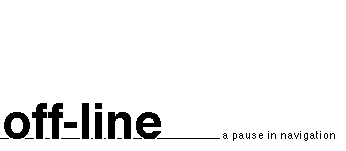Most of the articles in column aren’t about websites.
It’s more important to concentrate on the substance
(strategy, service, content) that comes before any specific
application. But there is a basic concept of site
construction that deserves a few comments.
It’s called architecture. And, indeed, the structure
of a site resembles a building. It has places, paths and functions.
I’ve heard some good web makers say that it isn’t
the architect’s job to define content. That’s right, if it
means that a good architecture can’t be planned unless there
are clear ideas of what it’s supposed to be and do. But it
becomes a widespread mistake when too many so-called web
experts think that architecture can be always the same,
regardless of its purpose.
The architecture of an office building isn’t the same as
a supermarket. A stadium isn’t made like a hotel. It makes no
sense to build a railway station in the same way as a theater.
Each architecture must be planned according to its
specific function. Le Corbusier used to say that a house is a
“machine for living” – it’s even more true
that a webisite is a machine for service. Hypertext is a wonderful
tool to offer the greatest possible complexity in the
simplest possible way for the reader. But doing that
effectively needs a great deal of thoughtful planning and care
in every detail. It isn’t easy to conceive, make, maintain
and develop an efficient reading machine. That is one of the
reasons why so many sites have poor architecture, hidden
behind a cumbersome and annoying smokescreen of appearances.
Many web makers appear to believe that a homepage is like
the outside of a building – or a shop window. It isn’t.
People don’t need to be attracted or invited in. When they
see the homepage they are already inside. They don’t want any
time-wasting introduction or confusing decorations. They need
a clear and easy path to find what they are looking for.
A good homepage must be functional. That doesn’t mean
that it has to be ugly. Efficient, streamlined structures can be much more
attractive than unnecessary and boring baroque complications..
Many websites are narcissistic. The owners are busy
bragging about themselves instead of telling us what’s in it
for us. The webmakers are busy showing off easy visual tricks
instead of helping us to find something interesting.
Superficial glitz is a cheap and easy trick to stay away from
doing any real work or offering any real service.
But – even when there is valuable content, and the
“knowledge machine” is well organized, architecture
isn’t enough. A building is designed to last over time. A
website grows like a tree. The best way is not to build a
skyscraper, but to start small and evolve gradually, learning
from experience. The architect must also be a farmer and a
gardener. I wrote about The cultivation
of the internet in this column in 1999 (and later that became
the title of a book.)
Everything online can be changed at any time. A website
should be updated as often as possible (or appropriate.) But
that doesn’t mean that it should change “for the sake of
change” – or lose its identity and continuity. It’s
biological, not mechanical. It’s rooted in human
relationships, not in technical devices.
An efficient building needs good plumbing and good
maintenance. But plumbers and janitors don’t design
buildings – or even bathrooms.
A well planned buinding is designed to please the eye
as well as for efficiency. But good decorators don’t
treat interiors like streets in Las Vegas.
Technologies are the tools, not the substance. The
disciplines that drive the conception and growth of online
projects come from two basic human activities: architecture
and gardening. Both need a deep blend of art and technique,
sensitivity and craftsmanship, intuition and reason, talent
and competence, imagination and experience.



